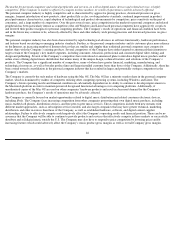Apple 2005 Annual Report Download - page 53
Download and view the complete annual report
Please find page 53 of the 2005 Apple annual report below. You can navigate through the pages in the report by either clicking on the pages listed below, or by using the keyword search tool below to find specific information within the annual report.
such solutions at a reasonable cost and in a timely manner, if at all, which could have a materially adverse effect on the Company’s operating
results and financial position.
The Company’s future performance is dependent upon support from third-party software developers. If third-party software applications cease
to be developed or available for the Company’s hardware products, then customers may choose not to buy the Company’s products.
The Company believes that decisions by customers to purchase the Company’s personal computers, as opposed to Windows-
based systems, are
often based on the availability of third-party software for particular applications such as Microsoft Office. The Company also believes the
availability of third-party application software for the Company’s hardware products depends in part on third-party developers’ perception and
analysis of the relative benefits of developing, maintaining, and upgrading such software for the Company’s products versus software for the
larger Windows market or growing Linux market. This analysis may be based on factors such as the perceived strength of the Company and its
products, the anticipated potential revenue that may be generated, continued acceptance by customers of Mac OS X, and the costs of
developing such software products. To the extent the minority market share held by the Company in the personal computer market has caused
software developers to question the Company’s prospects in the personal computer market, developers could be less inclined to develop new
application software or upgrade existing software for the Company’s products and more inclined to devote their resources to developing and
upgrading software for the larger Windows market or growing Linux market. Moreover, there can be no assurance software developers will
continue to develop software for Mac OS X, the Company’s operating system, on a timely basis or at all.
In June 2005, the Company announced its plan to begin using Intel microprocessors in its Macintosh computers. The Company plans to begin
shipping certain models with Intel microprocessors by June 2006 and to complete this transition to Intel microprocessors for all of its
Macintosh computers by the end of calendar year 2007. The Company depends on third-party software developers to timely develop current
and future applications that run on Intel and PowerPC microprocessors. The Company’s inability to timely deliver new Intel-based products, or
a decline in available applications that run on the Company’s PowerPC products or the lack of applications that run on Intel-based Macintosh
systems could have a materially adverse effect on the Company’s operating results and financial position.
In addition, past and future development by the Company of its own software applications and solutions may negatively impact the decision of
software developers, such as Microsoft and Adobe, to develop, maintain, and upgrade similar or competitive software for the Company’s
products. The Company currently markets and sells a variety of software applications for use by professionals, consumers, and education
customers that could influence the decisions of third-party software developers to develop or upgrade Macintosh-
compatible software products.
Software applications currently marketed by the Company include software for professional film and video editing, professional compositing
and visual effects for large format film and video productions, professional music production and music post production, professional and
consumer DVD encoding and authoring, professional digital photo editing and workflow management, consumer digital video and digital
photo editing and management, digital music management, desktop-based database management, word processing, and high-quality
presentations. The Company also markets an integrated productivity application that incorporates word processing, page layout, image
manipulation, spreadsheets, databases, and presentations in a single application. Discontinuance of third-party products for the Macintosh
platform, including Microsoft Office could have an adverse effect on the Company’s net sales and results of operations.
51
























